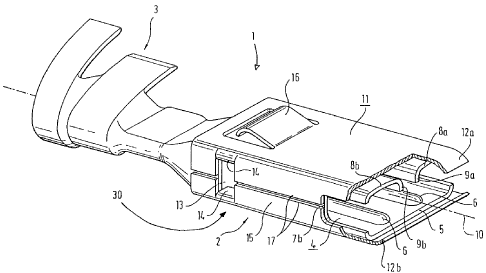Une partie des informations de ce site Web a été fournie par des sources externes. Le gouvernement du Canada n'assume aucune responsabilité concernant la précision, l'actualité ou la fiabilité des informations fournies par les sources externes. Les utilisateurs qui désirent employer cette information devraient consulter directement la source des informations. Le contenu fourni par les sources externes n'est pas assujetti aux exigences sur les langues officielles, la protection des renseignements personnels et l'accessibilité.
L'apparition de différences dans le texte et l'image des Revendications et de l'Abrégé dépend du moment auquel le document est publié. Les textes des Revendications et de l'Abrégé sont affichés :
| (12) Brevet: | (11) CA 2257988 |
|---|---|
| (54) Titre français: | DOUILLE CONNECTRICE |
| (54) Titre anglais: | CONNECTOR BUSHING |
| Statut: | Réputé périmé |
| (51) Classification internationale des brevets (CIB): |
|
|---|---|
| (72) Inventeurs : |
|
| (73) Titulaires : |
|
| (71) Demandeurs : |
|
| (74) Agent: | BKP GP |
| (74) Co-agent: | |
| (45) Délivré: | 2003-09-02 |
| (86) Date de dépôt PCT: | 1997-06-16 |
| (87) Mise à la disponibilité du public: | 1997-12-24 |
| Requête d'examen: | 2000-05-03 |
| Licence disponible: | S.O. |
| (25) Langue des documents déposés: | Anglais |
| Traité de coopération en matière de brevets (PCT): | Oui |
|---|---|
| (86) Numéro de la demande PCT: | PCT/EP1997/003117 |
| (87) Numéro de publication internationale PCT: | WO1997/049145 |
| (85) Entrée nationale: | 1998-12-11 |
| (30) Données de priorité de la demande: | |||||||||
|---|---|---|---|---|---|---|---|---|---|
|
L'invention concerne une douille de connecteur à fiches (1) comportant une zone d'enfichage (2) et une zone de connexion de conducteurs (3), la zone d'enfichage se présentant sous forme de douille (4) avec un fond (5), deux parois latérales (7a, 7b) cintrées vers le haut depuis le fond (5) et comportant une première et une seconde moitié de couverture (8a, 8b) qui partent des parois latérales et présentent des extrémités libres (9a, 9b) recourbées vers l'intérieur de la douille. La douille de connecteur à fiches (1) comporte une zone de base (30) médiane qui suit la zone d'enfichage (2), se présente sous forme de boîte, avec une partie de base, dans le prolongement du fond de la zone d'enfichage et avec une partie de couverture formée par une troisième et une quatrième moitié de couverture (18, 19), obtenues par cintrage des parois latérales de la zone de base médiane.
A plug connector sleeve (1) with a plug region (2) and a conductor connection
region (3), in which the plug region takes the form of a sleeve (4) with a
base (5), two side walls (7a, 7b) which are bent up from the base (5) and has
two cover halves (8a, 8b) running from the side walls and have free ends (9a,
9b) which are bent around towards the inside of the sleeve. The plug connector
sleeve (1) has a central base region (30) which follows the plug region (2),
is box-shaped with a base section, in the extension of the base of the plug
region with side walls in the extension of the side walls of the plug region
and with a cover section formed by third and fourth cover halves (18, 19)
which are formed by bending the side walls of the central base region.
Note : Les revendications sont présentées dans la langue officielle dans laquelle elles ont été soumises.
Note : Les descriptions sont présentées dans la langue officielle dans laquelle elles ont été soumises.

Pour une meilleure compréhension de l'état de la demande ou brevet qui figure sur cette page, la rubrique Mise en garde , et les descriptions de Brevet , États administratifs , Taxes périodiques et Historique des paiements devraient être consultées.
| Titre | Date |
|---|---|
| Date de délivrance prévu | 2003-09-02 |
| (86) Date de dépôt PCT | 1997-06-16 |
| (87) Date de publication PCT | 1997-12-24 |
| (85) Entrée nationale | 1998-12-11 |
| Requête d'examen | 2000-05-03 |
| (45) Délivré | 2003-09-02 |
| Réputé périmé | 2007-06-18 |
Il n'y a pas d'historique d'abandonnement
| Type de taxes | Anniversaire | Échéance | Montant payé | Date payée |
|---|---|---|---|---|
| Le dépôt d'une demande de brevet | 300,00 $ | 1998-12-11 | ||
| Enregistrement de documents | 100,00 $ | 1999-02-22 | ||
| Taxe de maintien en état - Demande - nouvelle loi | 2 | 1999-06-16 | 100,00 $ | 1999-04-26 |
| Requête d'examen | 400,00 $ | 2000-05-03 | ||
| Taxe de maintien en état - Demande - nouvelle loi | 3 | 2000-06-16 | 100,00 $ | 2000-05-03 |
| Taxe de maintien en état - Demande - nouvelle loi | 4 | 2001-06-18 | 100,00 $ | 2001-05-18 |
| Taxe de maintien en état - Demande - nouvelle loi | 5 | 2002-06-17 | 150,00 $ | 2002-06-05 |
| Taxe de maintien en état - Demande - nouvelle loi | 6 | 2003-06-16 | 150,00 $ | 2003-05-13 |
| Enregistrement de documents | 100,00 $ | 2003-06-02 | ||
| Enregistrement de documents | 100,00 $ | 2003-06-02 | ||
| Article 8 Corrections | 200,00 $ | 2003-06-02 | ||
| Taxe finale | 300,00 $ | 2003-06-09 | ||
| Taxe de maintien en état - brevet - nouvelle loi | 7 | 2004-06-16 | 200,00 $ | 2004-06-09 |
| Taxe de maintien en état - brevet - nouvelle loi | 8 | 2005-06-16 | 200,00 $ | 2005-05-27 |
Les titulaires actuels et antérieures au dossier sont affichés en ordre alphabétique.
| Titulaires actuels au dossier |
|---|
| FCI |
| Titulaires antérieures au dossier |
|---|
| F.C.I. - FRAMATOME CONNECTORS INTERNATIONAL |
| LEHNER, ANTON |
| MOSER, HANS |
| NOTTROTT, RUDOLF |